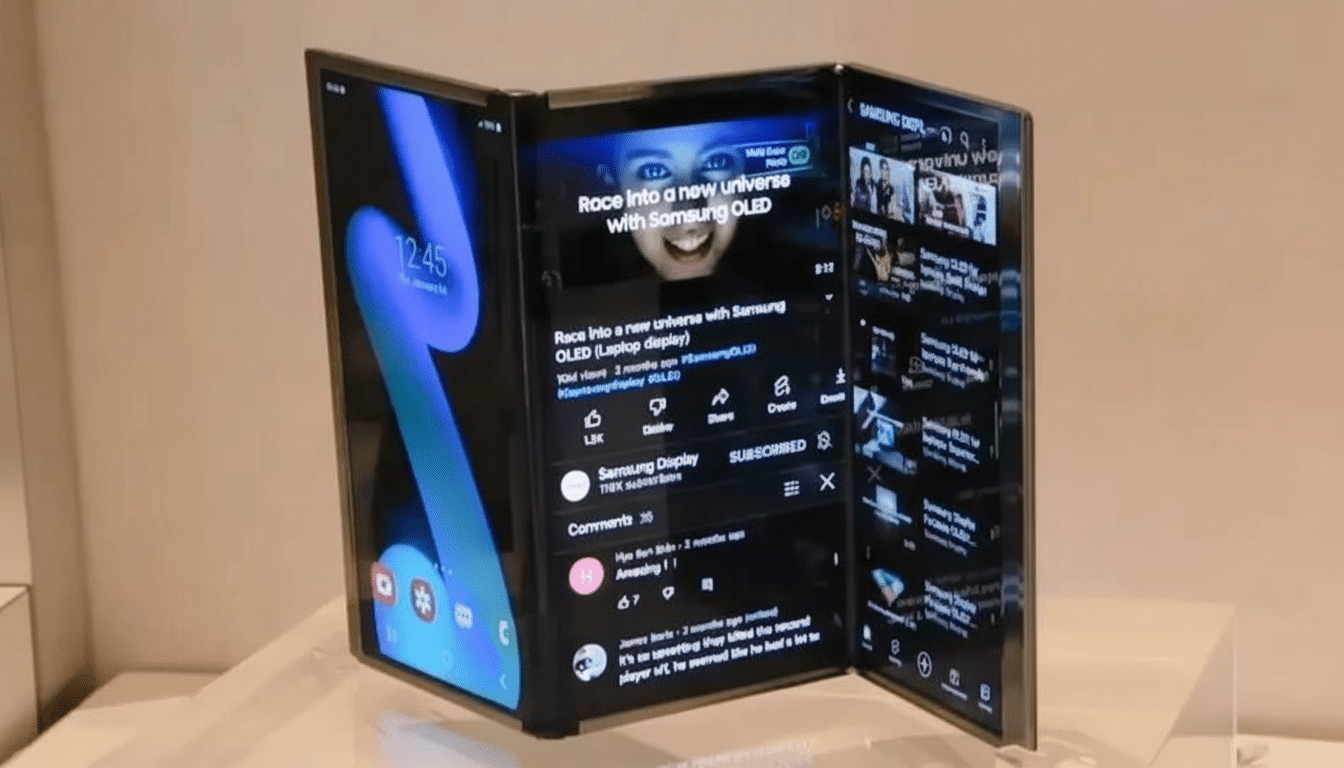A new leak indicates that Samsung’s much-rumored tri-fold phone will come in at less than the eye-watering sums we’ve heard whispered about previously, though there are many qualifications before anyone can claim a victory for affordability.
What the Latest Price Leak Indicates About Cost
A popular Korean blogger, yeux1122, said on Naver that the device — rumored to be referred to as Galaxy tri-fold — will carry a price tag around 3.6 million won in Korea, or about $2,446 based on the current exchange rate. The latter figure contradicts a previous rumor of 4 million won, which clocked in closer to $2,718.

The blogger did not cite any documentation but sourced the figure to an “internal sales channel announcement.” As with all pre-launch pricing rumors, be sure to apply salt. Even so, it’s a meaningful data point that suggests Samsung will be trying to avoid sticker shock on the first-generation version of a device that’s more complicated than its single-hinge foldables.
Even at the lower number, this tri-fold would carry a high premium over Samsung’s conventional book-style foldable. And the Galaxy Z Fold 7 in South Korea is on par with $1,616, and the tri-fold will cost hundreds more and be squarely positioned as an ultra-flagship for early adopters.
Why the Drop in Price Doesn’t Feel Cheaper
First, local pricing seldom converts on a 1:1 ratio across regions. VAT in Europe, state taxes in the US, currency fluctuations and carrier incentives can influence what buyers end up actually paying. But a phone that looks “cheaper” in won can hit close to or north of $2,000 elsewhere, and import costs might creep retail tags up anyway.
Second, the economics are unforgiving. And single-fold OLED modules — before the expense of cover glass, hinge systems and yields are accounted for — have been priced at over $100 by Display Supply Chain Consultants. A tri-fold needs even more panels, more-complicated hinges and layers of ultra-thin glass, or polymer, each multiplying risk and scrap rates. If yields begin at low levels, the savings are likely to be eaten by manufacturing inefficiencies.
Third, durability and serviceability could come with hidden costs of ownership. More hinges and a bigger fold area mean more potential points of failure, and repairs on foldables are already expensive compared with slabs. Early batch volumes are probably conservative, and the price tag that follows will reflect this as well; it keeps economies of scale in check and restricts how aggressive Samsung can be on pricing.
Finally, incentives can cloud the “real” price. Trade-in programs and launch bundles aim to offset the cost for the loyal early adopter, with the base MSRP staying steep. A low sticker isn’t necessarily synonymous with broad affordability.

What the Hardware Could Bring to Samsung’s Tri-Fold
On paper, the tri-fold looks to be a mobile workstation: an approximately 10-inch dual-folding internal display for tablet-level canvases, plus a 6.5-inch cover screen for phone-first tasks. That would be paired with a Snapdragon 8 Elite chipset — Qualcomm’s flagship silicon — and perhaps a battery closer to the 5,600mAh mark to make up for all of that screen real estate.
The camera setup is said to be a copy of the Z Fold 7’s, down to the components: a 200MP primary, 12MP ultrawide and 10MP 3x telephoto. That would deliver the results of familiar imaging chops, but make it a form factor story rather than a camera overhaul. The important considerations include weight, thickness and heat dissipation across two hinges as well as whether Samsung can achieve an IP rating similar to its single-fold devices.
Software might be the making or breaking of the idea. Samsung’s multi-window tools, taskbar and DeX already blur the lines between phone and PC. A tri-fold has to go a step further with seamless transitioning through three display states and app continuity. Without top-shelf optimization from Google and leading developers, the extra screen amounts to novelty rather than productivity.
Where the Foldable Market Stands and Who Leads Today
Foldables remain a niche. Counterpoint Research and IDC estimate that these make up less than 2% of worldwide shipments even as volumes in the category are increasing. Samsung has long dominated the category, but the rise of Chinese brands is intensifying competition and driving prices in single-fold segments lower. A tri-fold adds a new rung at the very top — a halo device that serves as an engineering showpiece, not a mass-market play.
If the leak is accurate, maybe Samsung’s also suggesting a commitment to keeping the tri-fold within reach of aspirations than the nearly $3,000 early rumors might lead one to fear. But the company will still have to juggle price, reliability and software polish to make leaving space for it in your life seem worth a sum over two times what premium slabs cost.
What to Watch Next Before Samsung’s Tri-Fold Debut
Seek sightings in certifications that expose battery capacity and charging speeds, carrier SKU leaks that speak to tiered regional pricing and any hint of support for S Pen — all keys to how much perceived value can be built into the comparisons. And watch whether Samsung’s display arm can boast improved crease tech or evidence of endurance rating claims over 200,000 folds; that would certainly reassure buyers.
A less expensive leak is good news for curiosity and competition. Just don’t call it a bargain. Until Samsung fills in the final pricing, availability and trade-in terms, though, the tri-fold will stay as a cutting-edge showcase — and an expensive one.

